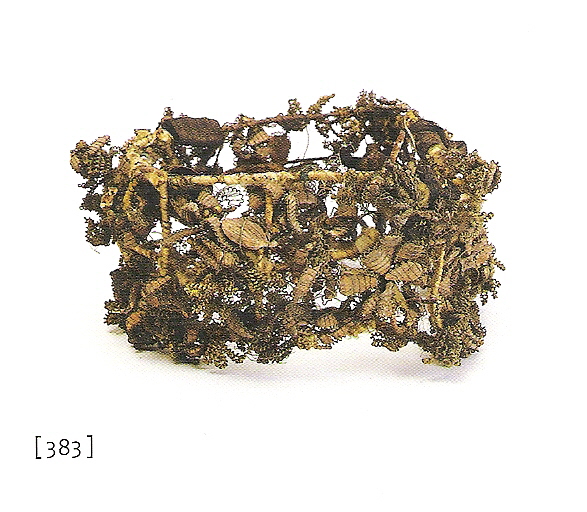|
The item pictured to the right - I've yet
to look into this one more closly:
Krone und Schleier: Kunst Aus Mittelalterlichen
Frauenklöstern 383 Heiligenkrone (Blütenkranz) aus Rostock
Rostock,
um 1500 | Draht, Seide, Glas-, (Türkis-) und hornperlen, organisches Marerial; H. ca. 5, Dm. ca. 8 (unten) und ca. 9 cm (oben)
| Staatliches Museum Schwerin, Kunstsammlungen, Inv. –Nr. MK 135
Noch 1593/1595 besaß das nunmehrige evangelische Damenstift 14 Heiligenkronen, zwei Marienkronen, eine Brautkrone sowie
die Kronen von sechs kleinen bekleideten Statuetten. Im Gegensatz zu der silbervergoldeten Krone aus St. Marienstern (Kat.
293) gehört die Rostocker mit ihrem Reifengestell und künstlichen Blüten wie die Brautkronen zum Typ der Blütenkränze und
wird gegen 1500 im Konvent angefertigt worden sein. Der Blütenkranz, seit nachreformatorischer Zeit einer thronenden Madonna
(Kat. 382) zugeordnet, zeichnet sich durch die reiche Verwendung organischer Materialien und des Spiraldrahtes aus. Seine
Herstellung entspricht den Blumenranken des ebenfalls im Rostocker Kloster entstandenen Tafelreliquiars mit Vesperbild (Inv.
Nr. MK 38).
Translated to:
Crown and Veil: Art from medieval woman-monasteries
383 holy crown (bloom ring) from Rostock Rostock, around 1500|Wire, silk, glass -,
(Turkish -) and horn beads, organic Marerial; H. approx. 5, DM. approx. 8 (down) and approx. 9 cm (above)|National museum
Schwerin, art collections, Inv. No. MK 135 Still 1593/1595 possessed mehrige Evangelist
lady pin 14 holy crowns, two Marien crowns, a bride crown as well as the crowns of six small dressed Statues. Contrary to
the silver-gilded crown from pc. Marienstern (Kat. 293) belongs the rust ochers with their wire rack and artificial blooms
like the bride crowns to the type of the bloom rings and against 1500 in the convention will have been made. The bloom ring,
since after reformationist time of one throne-end Madonna (Kat. 382) assigned, is characterised by the rich use of organic
materials and the spiral of wire. Its production corresponds the flower climbing in the rust ocher to monastery developed
board likewise reliquiars with Vesperbild (Inv. No. MK 38).
|
 |
|
A picture of the item described:

|
 |
|
From the book The Burdens
of Sister Margaret by Craig Harline
Klosterarbeiten – translated
from the German it means Monastery Work. These little altars or shrines were among the most stylish items in Catholic devotion
of the time. Developed in the fifteenth century, and perfected by nuns and beguines who often worked in tandem with lay painters
and woodcarvers, such shrines came to the Low
Countries by way of Brugge around 1500 and spread from there. Some were in the form of a triptych, as most altarpieces,
but much smaller, perhaps thirty-nine inches high by fifty inches wide. The wings, usually painted by professionals, portrayed
saints or benefactors of the house and order. But the central portion was the crucial and distinguishing part, for it was
usually fashioned by the nuns themselves, and often stood alone. It consisted of a fairly shallow case full of meticulously
carved figures – saints, angels, biblical characters, and so on – which were then adorned with a wagon full of
carefully crafted artificial flowers, usually from silk or parchment or even metal. Situated behind a small fence that might
stand amid imitation grass, here was the hortus conclusus, or enclosed garden, which was not only the usual symbol of Mary’s
virginity but also the place where the inspiring characters portrayed – and by implication the chaste viewer as well
– could best work out salvation.
Besides the general artistic
significance of the little altars, they likely reflected as well a distinctively female way of expressing religious feeling
or artistic prowess in this time – for cloistered women inevitably restricted worship to their home convent, while the
better-traveled male religious might worship in a multitude of places during his life and possess less motive or opportunity
for the careful embellishment of his house. Indeed, a comparison of decoration in male and female convents and parish churches,
may lead to the detection of genuinely different attitudes between the genders about form and manner of worship.
|
|